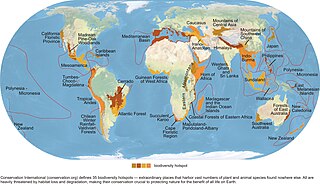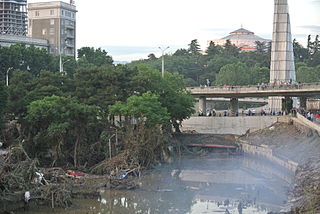
Deforestation or forest clearance is the removal of a forest or stand of trees from land that is then converted to non-forest use. Deforestation can involve conversion of forest land to farms, ranches, or urban use. The most concentrated deforestation occurs in tropical rainforests. About 31% of Earth's land surface is covered by forests at present. This is one-third less than the forest cover before the expansion of agriculture, with half of that loss occurring in the last century. Between 15 million to 18 million hectares of forest, an area the size of Bangladesh, are destroyed every year. On average 2,400 trees are cut down each minute.
An ecological or environmental crises occurs when changes to the environment of a species or population destabilizes its continued survival. Some of the important causes include:

Environmental degradation is the deterioration of the environment through depletion of resources such as quality of air, water and soil; the destruction of ecosystems; habitat destruction; the extinction of wildlife; and pollution. It is defined as any change or disturbance to the environment perceived to be deleterious or undesirable.

Land degradation is a process in which the value of the biophysical environment is affected by a combination of human-induced processes acting upon the land. It is viewed as any change or disturbance to the land perceived to be deleterious or undesirable. Natural hazards are excluded as a cause; however human activities can indirectly affect phenomena such as floods and bush fires.

Habitat destruction is the process by which a natural habitat becomes incapable of supporting its native species. The organisms that previously inhabited the site are displaced or dead, thereby reducing biodiversity and species abundance. Habitat destruction is the leading cause of biodiversity loss. Fragmentation and loss of habitat have become one of the most important topics of research in ecology as they are major threats to the survival of endangered species.

Human impact on the environment refers to changes to biophysical environments and to ecosystems, biodiversity, and natural resources caused directly or indirectly by humans. Modifying the environment to fit the needs of society is causing severe effects including global warming, environmental degradation, mass extinction and biodiversity loss, ecological crisis, and ecological collapse. Some human activities that cause damage to the environment on a global scale include population growth, neoliberal economic policies and rapid economic growth, overconsumption, overexploitation, pollution, and deforestation. Some of the problems, including global warming and biodiversity loss, have been proposed as representing catastrophic risks to the survival of the human species.

Environmental issues in Mali include desertification, deforestation, soil erosion, drought, and inadequate supplies of potable water. Deforestation is an especially serious and growing problem. According to the Ministry of the Environment, Mali’s population consumes 6 million tons of wood per year for timber and fuel. To meet this demand, 4,000 square kilometers of tree cover are lost annually, virtually ensuring destruction of the country’s savanna woodlands.

Environmentally, Colombia is a mega-diverse country from its natural land terrain to its biological wildlife. Its biodiversity is a result of its geographical location and elevation. It is the fourth largest South American country and only country in South America to have coasts on the Pacific and Caribbean Sea. Colombia's terrain can be divided into six main natural zones: The Caribbean, the Pacific, The Orinoco region, The Amazonia region, the Andean region, and the Insular region. 52.2% of the environment is predominately the Andes, Amazon, and Pacific Basins, followed by the Orinoco basin 13.9%, the Andes and the Caribbean. The Tropical Andes, Choco, and the Caribbean are considered biodiversity hotspots which puts these areas at high risk of concentration of colonizing activities. Colombia host over 1800 bird species and at least one new species are detected every year. Decades of civil war and political unrest have impeded biological and environmental research in Colombia. The political unrest in Colombia catalyzes the alteration of land patterns through the cultivation of coca and opium crops, the redirection of extractive activities, and land abandonment in some areas.

Environmental issues in Haiti include a historical deforestation problem, overpopulation, a lack of sanitation, natural disasters, and food insecurity. The major reasons for these environmental issues are corruption, human exploitation, and the embezzlement of taxpayers' funds for personal gains. In addition, there is not sufficient protection or management of the country's natural resources. Other environmental issues, such as decreases in precipitation and more severe natural disasters, will likely arise in Haiti as a result of climate change. Experts agree that Haiti needs to adopt new policies to address both the issues that already exist and to prepare for the effects of climate change.
The major environmental issues in Kyrgyzstan, are summarized in the 2007 Concept of Ecological Security of Kyrgyz Republic and discussed in other environmental and environmental policy documents such as National Environmental Action Plan (1995), Country Development Strategy for 2009–2011, Strategy on Biological Diversity (2002), 2nd Environmental Performance Review of Kyrgyzstan (2008), etc.
Environmental issues in Nepal include a number of issues, such as deforestation, climate change, energy and species conservation. Many of these issues have been precipitated by rapid industrialization without major environmental regulation.
Like most former republics of the Soviet Union, Azerbaijan experienced rapid economic development which has led to an increasingly negative impact on the environment, including the inefficient usage of natural resources. The government of Azerbaijan has aimed to increase environmental protection and ensure rational utilization of natural resources, and has introduced a number of important laws, legal documents and state programs in order to improve the ecological situation in the country. However, these precautionary laws have not been as effective as they were meant to be. Transparency has been a consistent issue in Azerbaijan, as NGOs who are given legal authority to collect data from the oil refineries are often blocked or dismissed, and their information is gathered unofficially. Domestic oil producers have often evaded the regulations, and have not prevented oil leaks into the Caspian Sea. In the next 30 years, Azerbaijan will produce more oil than it produced during the last century, and currently there is little coordination or environmental precaution in the oil drilling operations. There is also a lack of communication with neighboring countries bordering the Caspian Sea.
The environmental impact of agriculture is the effect that different farming practices have on the ecosystems around them, and how those effects can be traced back to those practices. The environmental impact of agriculture varies widely based on practices employed by farmers and by the scale of practice. Farming communities that try to reduce environmental impacts through modifying their practices will adopt sustainable agriculture practices. The negative impact of agriculture is an old issue that remains a concern even as experts design innovative means to reduce destruction and enhance eco-efficiency. Though some pastoralism is environmentally positive, modern animal agriculture practices tend to be more environmentally destructive than agricultural practices focused on fruits, vegetables and other biomass. The emissions of ammonia from cattle waste continue to raise concerns over environmental pollution.
The principal environmental issues in Peru are water pollution, soil erosion, pollution and deforestation. Although these issues are problematic and equally destructive, the Peruvian Environmental ministry has been developing regulation and laws to decrease the amount of pollution created in major cities and have been making policies in order to decrease the present deforestation rate in Peru.

Environmental issues in Serbia include air pollution, deforestation, various categories of threat to endemic species and climate changes. Several environmental organizations operating in Serbia have protested the government's handling of these issues.

There are many pressing environmental issues in Mongolia that are detrimental to both human and environmental wellness. These problems have arisen in part due to natural factors, but increasingly because of human actions. One of these issues is climate change, which will be responsible for an increase in desertification, natural disasters, and land degradation. Another is deforestation, which is expanding due to human recklessness, pests, disease, and fires. Mongolian lands are becoming more arid through desertification, a process that is being exacerbated due to irresponsible land use. Additionally, more and more species are disappearing and at risk for extinction. Moreover, especially in population centers, Mongolians deal with air and water pollution caused by industrialization.

Situated in the South Caucasus Region bordered by the Black Sea to the West, the Russian Federation to the North, Azerbaijan to the East, Turkey to the Southwest, and Armenia to the South, Georgia is a small country supplied with profitable natural resources, heavenly scenes, copious water assets, rich living spaces, and ecosystems that are of local and worldwide significance.
Biodiversity loss includes the worldwide extinction of different species, as well as the local reduction or loss of species in a certain habitat, resulting in a loss of biological diversity. The latter phenomenon can be temporary or permanent, depending on whether the environmental degradation that leads to the loss is reversible through ecological restoration/ecological resilience or effectively permanent. The current global extinction, has resulted in a biodiversity crisis being driven by human activities which push beyond the planetary boundaries and so far has proven irreversible.

Forests play a crucial role as valuable repositories of biodiversity, eradicating the habitat that supports numerous plant and animal species. In Nigeria, this phenomenon has resulted in the endangerment of various trees, shrubs, and animals, with some species facing depletion.













